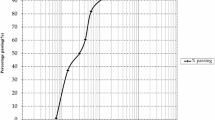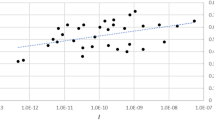Abstract
Soil shearing resistance is very important while designing various structures which have direct contact with soil, for example, sheet piles, piles, retaining walls, reinforced earth structures and shallow foundations. Even though designers use empirical values for their design, it is very important to obtain more accurate values for soil–solid materials shearing resistance. In this work, laboratory tests have been carried out to investigate the effect of roughness interface and texture models on friction angle between cohesive soils and steel, as well as abrasive paper material, using direct shear tests. All tests were carried out under consolidated drained shear conditions. The behavior at the soils–solid interface was found to vary according to surface roughness. It also seems that the type of material (steel or paper of abrasive) used does not have a major influence on the shear strength. As far as roughness is concerned, friction behavior is likely to be generally classified into three failure modes, namely full sliding at the interface, shear failure within the soil, and a mixed behavior where interface sliding and shear deformation of the soil specimen proceed simultaneously. However, for the second mode, the shear strength at the interface soil-rough solid materials steel was found to be lower than the shear strength of the soil, for a soil that is classified as high plasticity clay. Furthermore, it was found that the interfacial shear strength is independent of the texture surface for a given roughness.
















Similar content being viewed by others
References
Chu LM, Yin JH (2005) Comparison of interface shear strength of soil nails measured by both direct shear box tests and pullout tests. J Geotech Geoenviron Eng ASCE 131(9):1097–1107
Dejong JT, Frost D, Cargill E (2001) Effect of surface texturing on CPT friction sleeve measurements. J Geotech Geoenviron Eng 127(2):158–168
Esashi Y, Kataoka T, Yasuda M (1966) Uplift resistance of piles: part I. Cohesionless soil. Rep. 66037, Central Research Institute of Electric Power Industry, Tokyo, 1–60
Frost JD, Han J (1999) Behavior of interfaces between fiber-reinforced polymers and sands. J Geotech Geoenviron Eng 125(8):633–640
Hammoud F (2006) Contribution to the study of shear strength at the interface between cohesive soils and solid materials for large displacements, Ph.D. thesis (in french), University of Batna, Algeria
Jardine RJ, Chow FC (1996) New design methods for offshore piles. Marine Technology Directorate, London, publication 96/103
Lemos LJL, Vaughan PR (2000) Clay-interface shear resistance. Géotechnique 50(1):55–64
Paikowski SG, Player CM, Connors PJ (1995) A dual interface apparatus for testing unrestricted friction of soil along solid interfaces. Geotech Test J 18(2):168–193
Potyondy JG (1961) Skin friction between soils and construction materials. Géotechnique 11(4):339–353
Shakir RR, Zhu JG (2009) Behavior of compacted clay-concrete interface. Front Archit Civ Eng China 3(1):85–92
Smith DW, Reitsma MG (2002) Towards an explanation for the residual friction angle in montmorillonite clay soil. Environmental geomechanics. EPFL Press, Lausanne
Subba Rao KS, Allam MM, Robinson RG (1998) Interfacial friction between sands and solid surfaces. Geotech Eng Proc Instn Civ Eng 131:75–82
Subba Rao KS, Allam MM, Robinson RG (2000) Drained shear strength of fined-grained soil-solid surface interfaces. Geotech Eng Proc Instn Civ Eng 143:75–81
Suriyavut pra A (2013) Behaviour of soil-structure interfaces subjected to a large number of cycles. Application to piles. Thesis, University of Grenoble, France
Tan WH, Lee CY, Sivadass T (2008) Behaviour of clay-steel interfaces. Int Conf Construct Build Technol 2:11–20
Tsubakihara Y, Kishida H (1993) Frictional behaviour between normally consolidated clay and steel by two direct shear type apparatuses. Soils Found 33(2):1–13
Tsubakihara Y, Kishida H, Nishiyima T (1993) Friction between cohesive soils and steel. Soils Found 33(2):145–146
Uesugi M, Kishida H (1986) Influence factors of friction between steel and dry sands. Soils Found 26(2):29–42
Author information
Authors and Affiliations
Corresponding author
Rights and permissions
About this article
Cite this article
Feligha, M., Hammoud, F., Belachia, M. et al. Experimental Investigation of Frictional Behavior Between Cohesive Soils and Solid Materials Using Direct Shear Apparatus. Geotech Geol Eng 34, 567–578 (2016). https://doi.org/10.1007/s10706-015-9966-5
Received:
Accepted:
Published:
Issue Date:
DOI: https://doi.org/10.1007/s10706-015-9966-5




